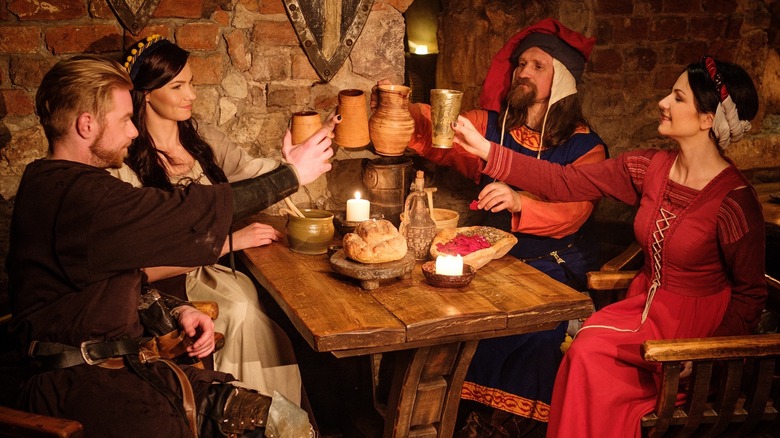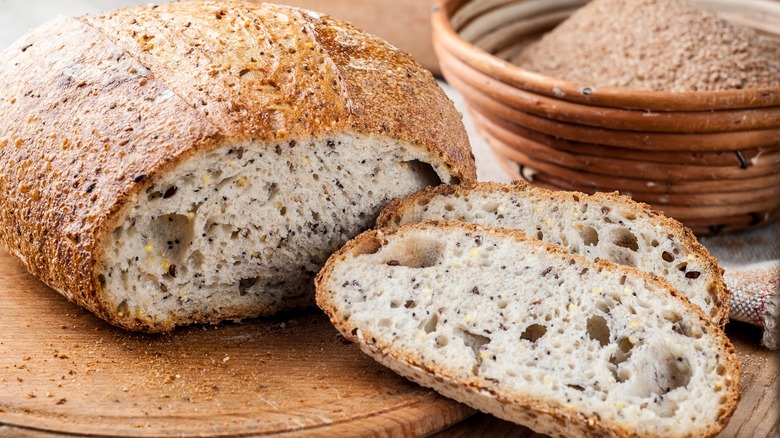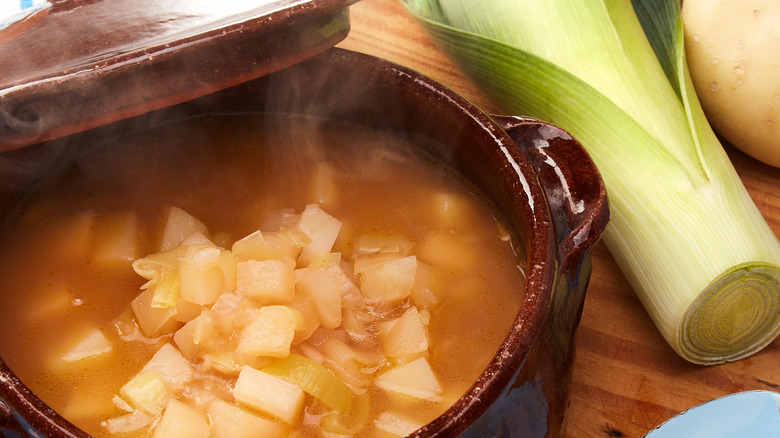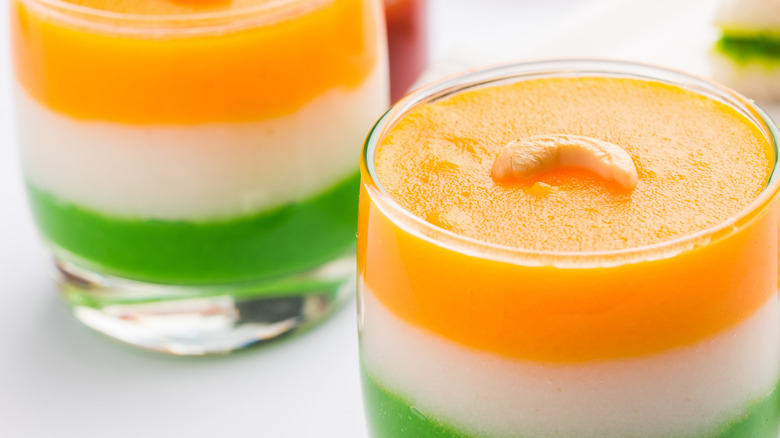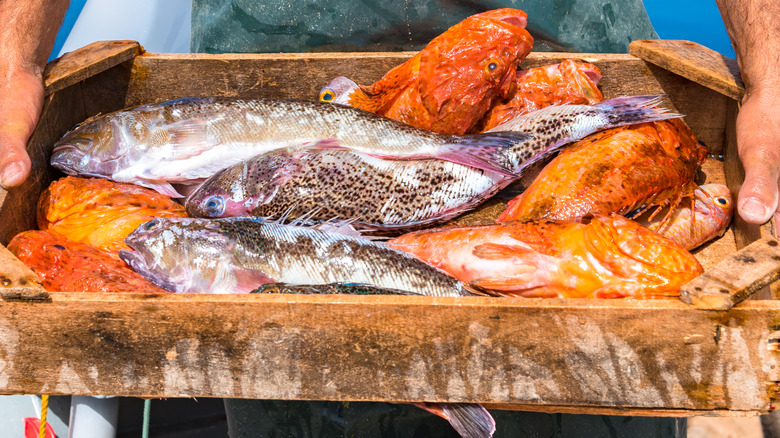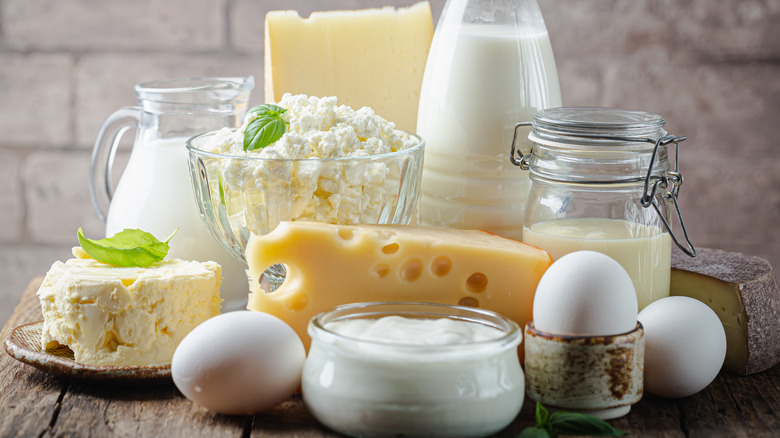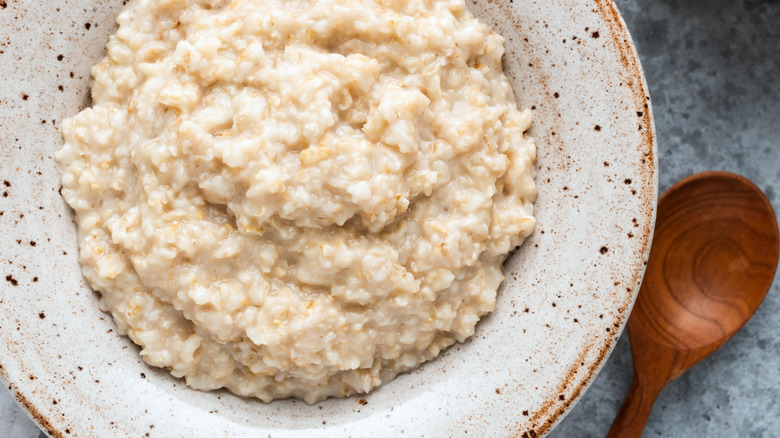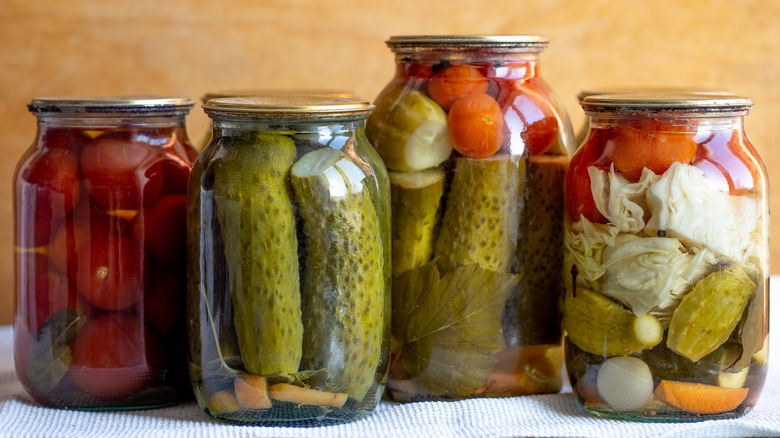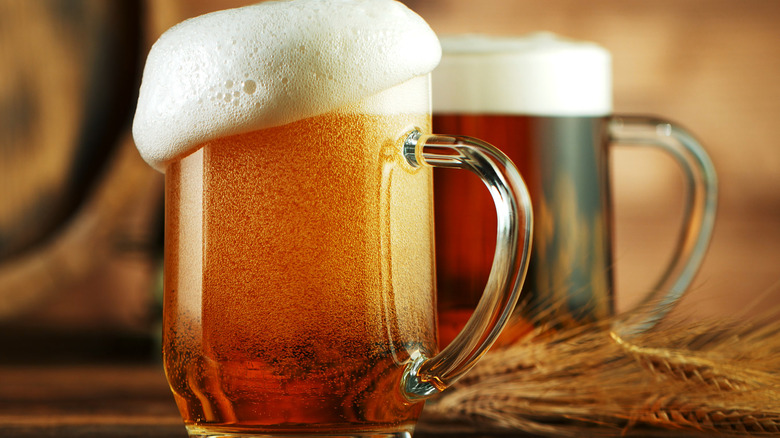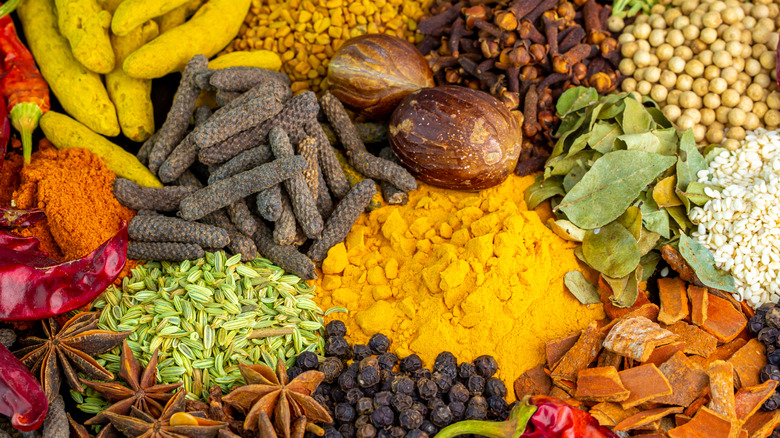What Did People Really Eat In The Middle Ages?
Believe it or not, there are several dozen handwritten cookbooks that have survived since the Middle Ages, revealing recipes and descriptions that are invaluable to historians and eye-opening for the rest of us who are just plain curious. Unfortunately, most of these recipes and traditions describe the culinary scene for just one class of medieval muncher: the nobility. Books weren't cheap in the Middle Ages, so it stands to reason that only the wealthier households would have stacks of books at all, let alone ones specifically dedicated to cooking. We shouldn't be surprised that their cookbooks were geared toward helping their staffs prepare the dishes and banquets served in their own homes, not those of the poor.
While peeping into the lives of the wealthy and extravagant in any period is exciting, you may be just as curious about what regular folks ate during the Middle Ages, though, and plenty of this information has been passed down, too, though not often in cookbooks. As such, we have more of a general sense of their ingredient availability and daily habits than of specific recipes they prepared, but it's unlikely you were aiming to whip up some medieval peasant dishes of your own anyway (and once you see what the nobles were eating, you probably won't want to prepare many of their recipes either). So, what did people really eat in the Middle Ages? You're about to find out.
They all broke bread
There's no modern country with a food tradition that doesn't include bread, and TechnoGym says that's been the case throughout most of history, too. In the Middle Ages, Europeans certainly broke bread with one another as commonly as they do today, and bread is one food that spanned the classes from nobles to serfs. According to Medieval Britain, grain-based foods like bread provided up to three-quarters of the calories eaten by medieval Brits. Some were even using scooped bread as plates in the Middle Ages, not unlike the bread bowls occasionally used to serve soup today. Of course, not all tables are created equally, and not all bread is either.
There were varying degrees of bread quality in the Middle Ages, and better bread was reserved for those who could afford it. The difference in quality between types of bread was generally attributed to the grain used to bake it. If you're wondering which bread was most preferable and expensive in the Middle Ages, you may be surprised to find that the answer is the opposite of today's standards. While we may pay more for ancient grains and darker breads today, per the History Learning Site, medieval diners preferred white bread, made from wheat, which was too expensive for most peasants to grow. The poorer classes often baked rye or barley breads and even resorted to peas, beans, and acorns to fill out a bread recipe when grains were in short supply.
Cooked fruits and veggies
Today we know that many fruits and vegetables are packed with nutrients that help our bodies, and your parents may have begun forcing them on you long before you liked them. Apparently, some things never change, because medieval recipes for fruit and veggie dishes abound, from fried beans and pea porridge to apple bread pudding and cherry pudding (via Gode Cookery). These prove either that the good people of the Middle Ages were also aware of the many potential health benefits of these natural beauties or at least that fruits and veggies were easy enough to grow. But not everything about the produce preferences of medieval diners is consistent with today's practices.
Some proponents of raw food diets believe that too many nutrients are lost when fruits and veggies are cooked, preferring to eat them only in their rawest form (or nearly so), but medieval chompers believed the opposite. Not only did they prefer not to eat their produce raw, but they actually thought that raw fruits and vegetables were dangerous, with one book bearing the alarming warning, "Beware of green salads and raw fruits, for they will make your master sick" (via the British Library). As some foods are dangerous to eat raw, and we may be able to assume food washing was less thorough than it can be today, it certainly may have been safer overall to just cook all produce before serving it in the Middle Ages, so let's not judge too hard.
Nobles had a thing for big sea animals
The wealthy have never shied away from grand demonstrations of their personal worth, especially during festivities attached to their own homes or names, so you shouldn't be surprised to learn that the banquets of the Middle Ages were no dim affairs. Medieval hosts loved to show off. Gracing the tables of many a medieval banquet were eye-catching presentations of less common animals, and plenty of them came from the sea. As the British Library reports, impressive sea life like seals, porpoises, and whales were no strangers to medieval banquet tables.
Still, a decadent presentation doesn't always indicate a quality bite, at least not by today's standards. Remember that porpoise presentation we just learned about? It may have been an impressive sight to behold, but one known preparation of this sea animal was porpoise pudding, which was, perhaps, even less enticing than it sounds (via Owlcation). To be short, it was a stuffed porpoise stomach. It could be compared to Scottish haggis, substituting a porpoise stomach for a sheep stomach. In this type of recipe, you're unlikely to taste much of the porpoise itself, as it's really just providing a casing and it's not necessarily the star ingredient, but hey — it's still in there, and medieval revelers apparently enjoyed having it.
Sugar sculptures started banquets
Continuing with the theme of splendid showpieces bedecking the tables of medieval banquets (hey, we already told you most of the surviving intel we have about what people ate in the Middle Ages comes from banquet cookbooks), sugar creations often stole the spotlight. They were the centerpieces of the table, much as deliciously decadent desserts are today. Unlike today, though, meals in the Middle Ages rarely included a distinct dessert course, presenting sweet dishes throughout the meal alongside the savory courses, as Bucknell University reports.
Much like we use sugary fondant to sculpt beautiful shapes and scenes for some of our most eye-popping desserts today, sugar sculptures called sotiltees (for those of you not versed in Middle English, that would be "subtleties" today), graced the medieval banquet table. Despite their falsely humble name, these sculptures were anything but subtle. They were complex designs intended to dazzle and impress the host's guests at any good Middle Ages banquet. Per the Abbey Medieval Festival, you could expect to see shapes like castles, animals, or even entire scenes from popular tales, and though sweet dishes could come at any time, subtleties generally announced the beginning of a banquet, serving as an introduction, not a conclusion. We only wonder if anyone ever actually ate them.
Colorful custards livened rich tables
One more sweet treat from the banquet tables of the nobles, and then we promise to consider the common folk again. While you may think that garishly colored candies and sweet treats are modern inventions, it seems that even banqueters in the Middle Ages were accustomed to vibrant hues infiltrating their sweet dishes, though they were far less artificially colored. More on that to come.
Common today, custard was an equally common dessert in the Middle Ages, at least for the rich (via Owlcation). Custard is a dairy-forward dish traditionally thickened with egg, and all of these ingredients were readily available to medieval chefs. Custard is a fairly broad term that can go beyond what you may consider a dessert food, but suffice it to say that it was, in fact, best known as a dessert in the Middle Ages, as it is for most of us today. In order to whip up rainbow-like dishes in modern times, we may have the convenience of adding a few drops of completely artificial food coloring to our recipes, but medieval chefs used natural ingredients to enliven their custards, including sandalwood for red, boiled blood for black, and saffron for yellow, according to the British Library.
People by the water had fish
We admit this one may seem a bit on the obvious side at first, but there's a teeny bit more to this story than may appear on the surface, so we're going take a somewhat deeper plunge here. Many of the more substantial dishes we've come across so far were reserved exclusively for the upper classes of medieval society, but fish was not necessarily relegated to the nobles. For those who lived near the sea, even the poor had ready access to fish. This made their diets different from those of the inland poor who dined on very little meat or fish at all.
Per Medieval Times, regardless of social status, living near the sea provided medieval eaters access to fresh cod, herring, eel, and even whale (not actually a fish, but let's move on). Those by streams and lakes similarly had access to freshwater fish, though the rules became a bit more classist here. As the History Learning Site explains, many medieval villages were built by rivers, and villagers were able to fish and eat species like dace, grayling, and gudgeon if the local lord permitted. But even in these cases, proper salmon and trout were generally reserved for the lord only, as were the contents of the stocked ponds they often kept on their large estates. Violators of this fishy hierarchy were subject to serious punishment.
Peasants depended on dairy
Remember that colorful custard situation we just learned about? You know, the custard concocted primarily with a sizable dose of dairy? This was made possible by the abundance of dairy products available to medieval people, and though custards were generally for the rich alone, dairy was not. There certainly were plenty of more refined dairy dishes like almond milk pie and cheese tarts being prepared for the ruling classes of the Middle Ages, but the British Library reports dairy cows were often kept by the medieval poor, so their diets included plenty of cheese, buttermilk, curds, and whey.
Cheese may be a wildly popular dairy product by today's standards, but it's probably not the first one you think of when considering the entire category of dairy. If you're like us, you think of milk first, but most imbibers of the Middle Ages did not. As Medieval Times reports, milk certainly existed in the Middle Ages, but it was primarily a drink for children and rarely guzzled by medieval adults. That is, of course, unless they were poor or sick, in which case they may have indulged in some childish milk for practical purposes like the desperation that comes from poor health or poor finances.
Everyone ate pottage
Let's take a step back into the universal favorites of Middle Ages diners. Like bread, just about every set of taste buds in medieval Europe was accustomed to enjoying some version of a widely popular soupy stew known as pottage. But also like bread, different classes ate different versions (via Medieval Recipes). At its most basic, pottage is not much more than a mishmash of ingredients boiled in stock and often thickened with a grain. It's the differences in the ingredients added to the stock that set apart rich-person pottage from poor-person pottage.
We'll start with the poor. Peasants made their pottages primarily from oats and flavored them most often with whichever vegetables they had available in the tiny little growing patches found alongside their homes. Leek was a favored pottage ingredient, but, of course, this depended on accessibility, and more meager times may have called for less zingy pottages like those made with peas and beans instead. If you could grow it, it went in the pottage. Cheap cereal-based pottages were classed as frumenty, while a more upper-crust pottage, known as mortew, would likely feature considerably more meat and a wider variety of vegetables than a peasant's oat pottage. At the end of the day, though, they're all pottages, no matter what they called them.
The poor ate pickled foods
Like most other readily available items on this list, it's fair to say that just about anyone in the Middle Ages would have chowed down on pickled foods from time to time, including the well-heeled nobility. Much like today, though, fresh food was generally considered more desirable, so the wealthy leaned toward fresh ingredientsas often as possible, leaving the pickled foods to the peasants, who didn't have large numbers of animals to slaughter whenever the craving struck or the ability to source fresh vegetables throughout the calendar.
Pickling was hardly different in the Middle Ages than it is today, consisting of tightly jarring fish, veggies, or eggs in an acidic brine featuring lemon juice, verjuice, or vinegar (via Castles and Manor Houses). The primary purpose was shelf stabilization, allowing the poor to eat the foods they needed all year long without having to subject everything to salting or drying. Among the most commonly pickled foods in poorer diets were herring and fruits, while bacon was, unsurprisingly, reserved for salting. Pork was one meat that even peasants had somewhat easy access to since pigs were cheap to keep and required little care, feeding themselves in their forest homes. Today we'd call them free-range.
Ale flowed freely
We'll start by identifying the difference between ale and beer in medieval society, and that difference rested solely in beer's addition of hops to the ale recipe of water, grain, and the all-important yeast that was needed for fermentation. While you may come across some sources that say that beer was a common drink for all in the Middle Ages, the reality is that ale, by the medieval definition of these distinct beverages, was the drink flowing freely for people of most classes during these times.
You may have noticed that most of the foods and drinks consumed by medieval peasants were those that were readily and cheaply available, and it's certainly not difficult to understand why that would be. Ale, though, is a major exception to this rule. Unlike everything else peasants enjoyed, ale was not easy to produce in the Middle Ages (via the History Learning Site). On the contrary, it took several days to brew and required careful preparation by trained individuals. Regardless, ale remained the primary beverage of any good medieval village and was consumed by rich and poor alike with every meal of the day, including breakfast.
Spice was king
There are equal parts fact and fiction surrounding the claim that spices were widely used in medieval cuisine, and we're going to address both. As fiction can often be more fun, let's start there: Persistent lore surrounding the Middle Ages claims that spices were heavily used to disguise the horrid taste of rotting meat in a society lacking the benefit of refrigeration (via Washington State University). By now, you may already be able to debunk this one yourself, having just learned the ways in which medieval people preserved meat by drying and salting, but there's an even more obvious reason to disregard this notion: Spices were very expensive, so there was little chance they would be wasted on bad meat (something the rich weren't eating anyway), or that the poor had access to them at all.
In reality, most spices available to noble Europeans of the time were all imported from Asia and Africa. These were considered serious luxuries that displayed wealth and power. Humble black pepper, which is on every modern table today, was economically treated like gold bullion in some ways. Also commonplace and inexpensive today, sugar was rare and valuable in the Middle Ages. It was considered a spice, which may help explain why sweet dishes were not separated from savory dishes at banquets. Still, there were some spices that grew readily in Europe, like mustard, and those were available even to the peasants who grew them alongside herbs like dill and mint.
